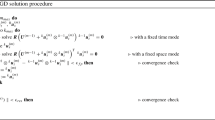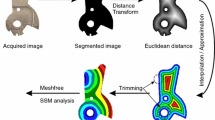Abstract
For repeated transient solutions of geometrically nonlinear structures, the numerical effort often poses a major obstacle. Thus it may become necessary to introduce a reduced order model which accelerates the calculations considerably while taking into account the nonlinear effects of the full order model in order to maintain accuracy. This work yields an integrated method that allows for rapid, accurate and parameterisable transient solutions. It is applicable if the structure is discretised in time and in space and its dynamic equilibrium described by a matrix equation. The projection on a reduced basis is introduced to obtain the reduced order model. Three approaches, each responding to one of the requirements of rapidity, accuracy and parameterisation, are united to form the integrated method. The polynomial formulation of the nonlinear terms renders the solution of the reduced order model autonomous from the finite element formulation and ensures a rapid solution. The update and augmentation of the reduced basis ensures the accuracy, because the simple introduction of a constant basis seems to be insufficient to account for the nonlinear behaviour. The interpolation of the reduced basis allows adapting the reduced order model to different external parameters. A Newmark-type algorithm provides the backbone of the integrated method. The application of the integrated method on test-cases with geometrically nonlinear finite elements confirms that this method enables a rapid, accurate and parameterisable transient solution.








Similar content being viewed by others
References
Amabili M (2008) Nonlinear vibrations and stability of shells and plates. Cambridge University Press, New York
Amsallem D, Cortial J, Carlberg K, Farhat C (2009) A method for interpolating on manifolds structural dynamics reduced-order models. Int J Numer Methods Eng 80:1241–1258
Amsallem D, Farhat C (2008) Interpolation method for the adaptation of reduced-order models to parameter changes and its application to aeroelasticity. AIAA J 46:1803–1813
Argyris JH, Mlejnek HP (1991) Dynamics of structures. North Holland, New York
Bathe KJ (1996) Finite element procedures. Prentice-Hall, Englewood Cliffs
Besselink B, Tabak U, Lutowska A, van de Wouw N, Nijmeijer H, Rixen D, Hochstenbach M, Schilders W (2013) A comparison of model reduction techniques from structural dynamics, numerical mathematics and systems and control. J Sound Vib 332(19):4403–4422. doi:10.1016/j.jsv.2013.03.025
Bui-Thanh T, Willcox K, Ghattas O, van Bloemen Waanders B (2007) Goal-oriented, model-constrained optimization for reduction of large-scale systems. J Comput Phys 224(2):880–896. doi:10.1016/j.jcp.2006.10.026
Chang YW, Wang X, Capiez-Lernout E, Mignolet MP, Soize C (2011) Reduced order modeling for the nonlinear geometric response of some curved structures. In: International forum of aeroelasticity & structural dynamics (IFASD), Paris
Ewins DJ (2000) Modal testing, theory, practice and application, 2nd edn. Research Study Press LTD, Baldock
Feeny BF, Liang Y (2003) Interpreting proper orthogonal modes of randomly excited vibration systems. J Sound Vib 265(5):953–966. doi:10.1016/S0022-460X(02)01265-8
Galbally D, Fidkowski K, Willcox K, Ghattas O (2010) Non-linear model reduction for uncertainty quantification in large-scale inverse problems. Int J Numer Methods Eng 81(12):1581–1608. doi:10.1002/nme.2746
Grolet A, Thouverez F (2012) On the use of the proper generalised decomposition for solving nonlinear vibration problems. In: ASME 2012 international mechanical engineering congress & exposition, IMECE, Houston
Hackbusch W (2012) Tensor spaces and numerical tensor calculus. Springer, Heidelberg
Hadigol M, Doostan A, Matthies HG, Niekamp R (2013) Partitioned treatment of uncertainty in coupled domain problems: a separated representation approach. http://arxiv.org/abs/1305.6818v1. Retrieved 8 Nov 2013
Har J, Tamma KK (2012) Advances in computational dynamics. Wiley, New York
Hay A, Borggaard J, Akhtar I, Pelletier D (2010) Reduced-order models for parameter dependent geometries based on shape sensitivity analysis. J Comput Phys 229(4):1327–1352. doi:10.1016/j.jcp.2009.10.033
Hay A, Borggaard JT, Pelletier D (2009) Local improvements to reduced-order models using sensitivity analysis of the proper orthogonal decomposition. J Fluid Mech 629:41–72
Hemez FM, Doebling SW (2001) Review and assessment of model updating for non-linear, transient dynamics. Mech Syst Signal Process 15(1):45–74. doi:10.1006/mssp.2000.1351
Hilber HM, Hughes TJR, Taylor RL (1977) Improved numerical dissipation for time integration algorithms in structural dynamics. Earthq Eng Struct Dyn 5:283–292
Hollkamp JJ, Gordon RW, Spottswood SM (2005) Nonlinear modal models for sonic fatigue response prediction: a comparison of methods. J Sound Vib 284(3–5):1145–1163. doi:10.1016/j.jsv.2004.08.036
Holzapfel GA (2000) Nonlinear solid mechanics: a continuum approach for engineering. Wiley, Chichester
Idelsohn SR, Cardona A (1985) A load-dependent basis for reduced nonlinear structural dynamics. Comput Struct 20(1–3):203–210. doi:10.1016/0045-7949(85)90069-0
Krenk S (2009) Non-linear modeling and analysis of solids and structures. Cambridge University Press, Cambridge
Lülf FA, Tran DM, Ohayon R (2013) Reduced bases for nonlinear structural dynamic systems: a comparative study. J Sound Vib 332:3897–3921
Matthies HG, Strang G (1979) The solution of nonlinear finite element equations. Int J Numer Methods Eng 14:1613–1626
Mignolet MP, Przekop A, Rizzi SA, Spottswood SM (2013) A review of indirect/non-intrusive reduced order modeling of nonlinear geometric structures. J Sound Vib 332(10):2437–2460. doi:10.1016/j.jsv.2012.10.017
Mignolet MP, Soize C (2008) Stochastic reduced order models for uncertain geometrically nonlinear dynamical systems. Comput Methods Appl Mech Eng 197:3951–3963. doi:10.1016/j.cma.2008.03.032
Muravyov AA, Rizzi SA (2003) Determination of nonlinear stiffness with application to random vibration of geometrically nonlinear structures. Comput Struct 81(15):1513–1523. doi:10.1016/S0045-7949(03)00145-7
Newmark NM (1962) A method of computation for structural dynamics. Trans Am Soc Civ Eng 127(1):1406–1432
Nickell R (1976) Nonlinear dynamics by mode superposition. Comput Methods Appl Mechanics Eng 7(1):107–129. doi:10.1016/0045-7825(76)90008-6
Noor AK (1981) Recent advances in reduction methods for nonlinear problems. Comput Struct 13(1–3):31–44. doi:10.1016/0045-7949(81)90106-1
Phillips JR (2003) Projection-based approaches for model reduction of weakly nonlinear, time-varying systems. IEEE Trans Comput Aided Des Integr Circuits Syst 22(2):171–187
Reichel L (1985) On polynomial approximation in the complex plane with application to conformal mapping. Math Comput 44:425–433
Späth H (1995) Two dimensional spline interpolation algorithms. A.K. Peters, Ltd., Wellesley
Spottswood S, Allemang R (2006) Identification of nonlinear parameters for reduced order models. J Sound Vib 295(1–2):226–245. doi:10.1016/j.jsv.2006.01.009
Strang G (2006) Linear algebra and its applications, 2nd edn. Thomson, Belmont
Tran DM (2009) Component mode synthesis methods using partial interface modes: application to tuned and mistuned structures with cyclic symmetry. Comput Struct 87:1141–1153
Wriggers P (2008) Nonlinear finite element methods. Springer, Berlin
Zienkiewicz O, Taylor R, Zhu J (2005) The finite element method: its basis and fundamentals. McGraw-Hill, New York
Acknowledgments
The fourth author gratefully acknowledges the support of Alexander von Humboldt Foundation through a Gay Lussac Research Award received in 2013.
Author information
Authors and Affiliations
Corresponding author
Rights and permissions
About this article
Cite this article
Lülf, F.A., Tran, DM., Matthies, H.G. et al. An integrated method for the transient solution of reduced order models of geometrically nonlinear structures. Comput Mech 55, 327–344 (2015). https://doi.org/10.1007/s00466-014-1103-4
Received:
Accepted:
Published:
Issue Date:
DOI: https://doi.org/10.1007/s00466-014-1103-4




